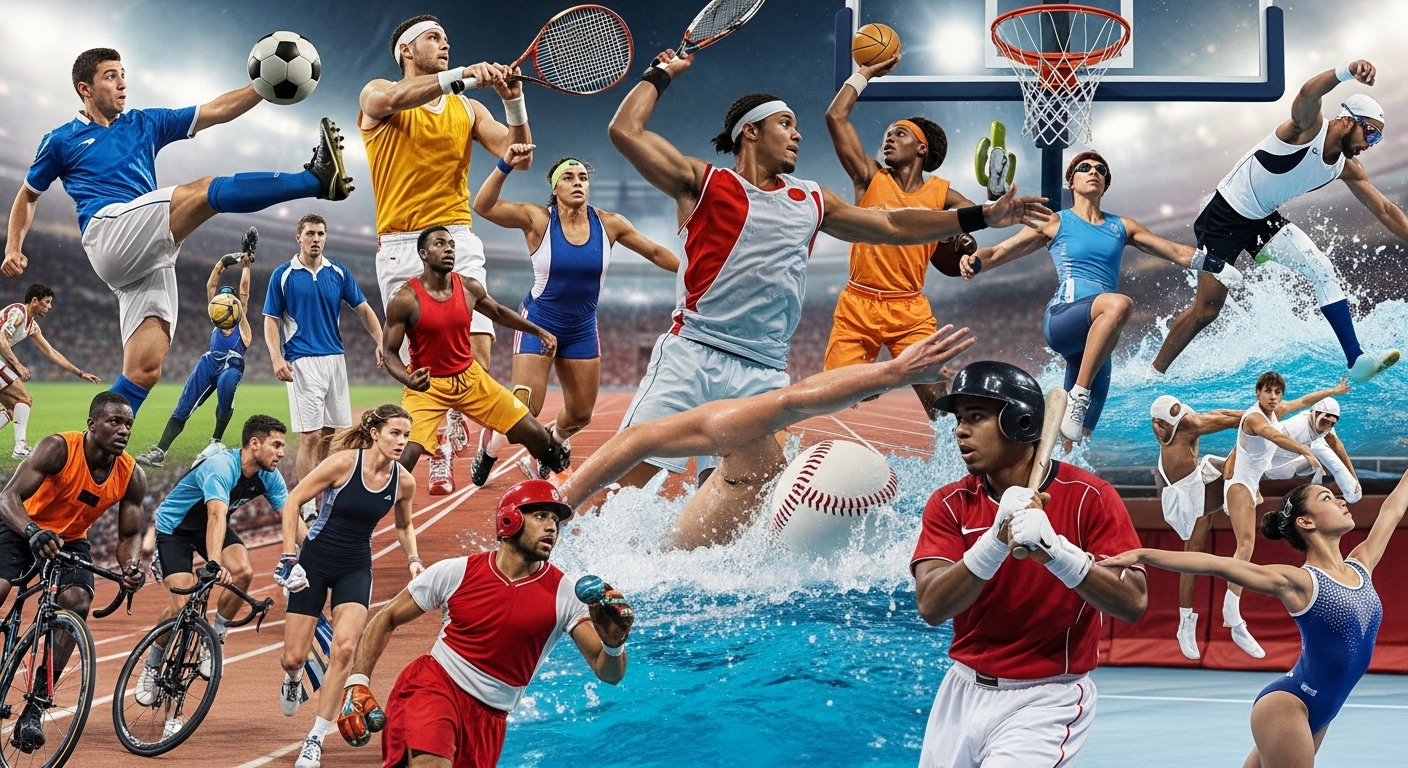Sports have always been an integral part of human culture, whether as a form of entertainment, a method of socializing, or as a means to showcase physical prowess. Over the centuries, sports have evolved from informal, local pastimes to global spectacles, with millions of fans across the world. Today, sports influence society in various ways, from contributing to economic development to promoting social cohesion.
This blog post will delve into the rich history and transformation of sports, exploring how the modern sports industry has evolved, how globalized sports have changed societal values, and the technological innovations that continue to shape the future of sports.
The Origins of Sports: Ancient Beginnings
The earliest forms of organized sports date back to ancient civilizations, where physical contests were not just for entertainment, but also for religious and social purposes. The ancient Greeks, for example, are widely credited with laying the foundations for modern sports through the creation of the Olympic Games. The first Olympic Games were held in 776 BCE in Olympia, Greece, primarily as a way to honor Zeus, the king of the gods.
Other ancient cultures, such as the Egyptians, Chinese, and Mayans, also had their own forms of sports and physical games. These early sports often involved combat, hunting, or other activities meant to prepare young men for the challenges of adulthood. The concept of competition, self-discipline, and physical endurance were central to these early practices, laying the groundwork for the athletic pursuits we know today.
The Birth of Modern Sports: A Global Movement
The modern era of sports can be traced to the 19th century, particularly in Europe and North America. During this period, several key factors came together to help shape the development of modern sports. Industrialization, urbanization, and the rise of a middle class with leisure time all contributed to the popularity of organized sports.
One of the key milestones in the development of modern sports was the codification of rules. Prior to the 19th century, sports were played according to regional traditions, which often led to confusion and disagreements. In England, for example, soccer and rugby both have roots in ancient games, but their modern forms only emerged after the establishment of standardized rules. In 1863, the Football Association (FA) was founded in England, and this led to the formation of the modern game of soccer (or football, as it is known in most parts of the world).
Similarly, other sports such as cricket, tennis, and basketball underwent standardization of rules, which allowed them to spread globally. The late 19th and early 20th centuries saw the formation of governing bodies and federations, which helped regulate sports on an international scale. This was also the period when the concept of professional sports leagues and competitions began to take shape.
Globalization of Sports: Bridging Cultures and Creating Identities
As sports continued to evolve, the 20th century saw the rise of globalized sports, with events such as the FIFA World Cup, the Olympic Games, and the Super Bowl attracting millions of viewers across continents. The invention of television in the mid-20th century played a key role in this global spread, bringing sports events into living rooms around the world.
The FIFA World Cup, first held in 1930, became one of the most-watched events in the world, attracting an audience that far surpassed the population of many countries. The Olympics, which had been re-established in 1896, grew in prominence throughout the 20th century. The 1960s and 1970s saw an increase in the number of countries participating, as well as a greater representation of women in various sports.
Globalization not only facilitated the international spread of sports but also changed the way people identified with them. Sports began to transcend national boundaries, creating a shared cultural language. International tournaments became a way for countries to showcase their prowess on a global stage, fostering a sense of pride and unity.
Additionally, globalization brought about the commercialization of sports. Sponsorship deals, advertising, and endorsements began to flood sports events and athletes themselves, turning athletes into global icons and transforming sports into multi-billion-dollar industries. The brand power of sports grew, with athletes like Michael Jordan, Serena Williams, and Cristiano Ronaldo transcending their respective sports to become global cultural figures.
Technological Advancements and Their Impact on Sports
The impact of technology on sports cannot be overstated. In the modern era, technological innovations have revolutionized nearly every aspect of sports, from training and performance analysis to broadcasting and fan engagement.
Performance Analytics and Wearable Technology
One of the most significant technological changes in sports has been the introduction of performance analytics and wearable technology. Devices like smartwatches, GPS trackers, and heart rate monitors have become standard equipment for athletes across different sports. These tools provide real-time data that coaches and athletes can use to fine-tune performance, track recovery, and optimize training.
For example, in soccer, players’ movements are now tracked using GPS devices, allowing coaches to analyze running distances, sprints, and positioning during matches. In basketball, wearables can track metrics like shooting accuracy, jump height, and fatigue levels. This data has led to more scientific approaches to coaching, with evidence-based methods replacing traditional “gut-feeling” coaching strategies.
Video Analysis and Refereeing Technology
Another area where technology has had a profound effect is in refereeing and officiating. The introduction of systems like Video Assistant Referee (VAR) in soccer has fundamentally changed how decisions are made on the field. The use of video replay has helped reduce errors in officiating, ensuring more accurate calls on critical moments in games.
In tennis, the “Hawk-Eye” system allows players and umpires to track the trajectory of a ball and determine whether it is in or out, minimizing the potential for human error. Similar systems are being used in cricket, rugby, and other sports.
Enhanced Fan Experience
Technology has also transformed the fan experience. With the advent of high-definition broadcasting, fans can watch games with unparalleled clarity, and innovations like virtual reality (VR) are beginning to offer fans the ability to immerse themselves in games as if they were sitting courtside or in the front row of a stadium.
Additionally, sports teams and leagues are increasingly using social media platforms to connect with fans, offering behind-the-scenes content, live updates, and direct communication with athletes. The rise of esports, which combines gaming with traditional sports elements, has created a new dimension for fan engagement.
The Role of Women in Modern Sports
In the past, sports were largely dominated by men, and women had limited opportunities to participate at a competitive level. However, over the past few decades, the landscape for women in sports has dramatically changed, thanks in large part to the feminist movement and the push for gender equality.
The formation of women’s leagues, such as the WNBA (Women’s National Basketball Association) and the Women’s Football League, has given female athletes more visibility and support. The inclusion of women’s events in the Olympic Games, which started in the early 20th century, has also contributed to greater participation and recognition of female athletes on the world stage.
Athletes like Serena Williams, Simone Biles, and Megan Rapinoe have become role models for young girls aspiring to break barriers and achieve greatness in sports. The popularity of women’s sports has grown significantly, and while there is still much work to be done in terms of equal pay and media coverage, the future of women’s sports looks brighter than ever.
The Intersection of Sports and Society
Sports often reflect the values, politics, and social movements of their time. Over the years, athletes have used their platforms to address important issues, whether it be racial inequality, LGBTQ+ rights, or environmental concerns. The intersection of sports and society has led to some powerful moments in history, such as:
- The Civil Rights Movement: In the 1960s, athletes like Muhammad Ali and Tommie Smith used their fame to take a stand against racial injustice. Ali famously refused to fight in the Vietnam War, and Smith and John Carlos raised their fists in a Black Power salute during the 1968 Olympic Games.
- The LGBTQ+ Movement: Athletes like Billie Jean King and Megan Rapinoe have been vocal advocates for LGBTQ+ rights, breaking barriers for gay and lesbian athletes and helping to foster a more inclusive environment in sports.
- Environmental Concerns: In recent years, there has been a growing awareness of the environmental impact of sports. From the carbon footprint of large sporting events to the waste generated by stadiums, there is a push for sustainability in sports, with initiatives like green stadiums and environmentally friendly practices gaining traction.
The Future of Sports: Trends to Watch
Looking ahead, the future of sports is likely to be shaped by several key trends:
- Esports and Virtual Sports: With the rise of gaming culture, esports has emerged as a major industry in its own right, attracting millions of fans and generating billions in revenue. Esports tournaments are being broadcast on traditional sports networks, and games like League of Legends and Fortnite are now considered major sports events.
- Enhanced Fan Engagement: Augmented reality (AR) and virtual reality (VR) will continue to evolve, providing fans with immersive experiences. Virtual sports could become more popular, allowing fans to engage with simulated versions of their favorite sports.
- Increased Focus on Mental Health: As awareness of mental health issues increases, there is likely to be a growing emphasis on the mental well-being of athletes. Mental health support, mindfulness training, and reducing the stigma around mental health will likely play a more prominent role in the future of sports.
- More Inclusive Sports: With greater emphasis on inclusivity, we may see an even broader range of people participating in sports, including individuals with disabilities, as adaptive sports continue to gain popularity.




